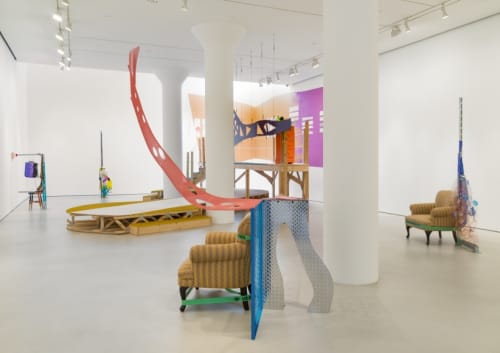In a talk on the painter Elizabeth Murray in 2005, Jessica Stockholder remarked that Murray’s pictures, in doing away with flat rectangular canvases while retaining naturalistic representation and illusion, embody “a duality between aggressive challenge to convention and a conservative love tradition.” As so often when artists discuss artists they admire, Stockholder might almost have been describing herself, responding to something in Murray that she recognized in her own practice. Or so it seems to me, looking at her work’s combination of formal sculptural concerns and found-object spectacle. Stockholder is interested in how objects support themselves and are supported, how they handle weight, their stiffness or softness, the textures of their surfaces, their qualities color and light. She often realizes these interests, though, through an anomalous array of miscellaneous stuff–for example, to cite the media list of one of the works in her recent show, “industrial metal fencing, dance floor tile, leather, vinyl, rope hardware, floor tile, floor mat, masonry square tile, bent metal rod, acrylic and oil paint,” and many things beyond, in this show including a couple of entire armchairs. The mention of acrylic and oil paint, incidentally, isn’t actually incidental, given the painterly delight in color that animates all Stockholder’s work, and the frequent use of framing devices and of the wall. Meanwhile, the objects she uses are still identifiable as themselves, introducing their own set of histories and associations, even at the same time that they merge and melt into the larger installations in which she combines them.
The words in that media list have a certain poetry, and Stockholder seems to take a poet’s relish in language. The title of the exhibition, “The Guests All Crowded into the Dining Room,” aptly conveys its character as visual experience, with its several sculptural assemblages dotted around a large construction that seemed to fill the space: a tall platform of two-by-fours and plywood, scalable by a set of steps at one end, and with curving underneath it a sloping runway, an alternative, gentler route up or down. Climbing the platform put the visitor close to an area of wall painted in panels of orange and pink, where Stockholder had mounted a group of abstract drawings , a gallery within a gallery. Here, though, while partly protected by a kind of hanging spatula-shaped shield running along the platform’s length dark purple, and opened up by triangular cutouts–viewers themselves may have felt put on display, perched for inspection from the rest of the room. The sensation was heightened on the runway, which set visitors descending it facing those entering the space, as if coming to greet each other.
In Assist: Smoke and Mirrors (all works 2016), a cloud of delicate copper wire, festooned with shiny bits of plastic and metal, falls to the side of an upholstered striped armchair harnessed to a vertical metal strut by yellow webbing. Security Detail also features a support for the body, this time a wooden stool, and a vertical metal strut, which turns in a right angle at the top to aim directly at the wall, ending a couple of inched short of a pair of painted panels that hang there. The colors and textures of these and the other works scattered about the room produced a slightly chaotic buzz, which contributed to the show’s feeling of a happy dinner party. Like the consumer products detailed in Pop art, or the store-bought doodads that Haim Steinbach lines up on shelves, they point in societal directions and suggest social trends: If Stockholder were making these works in the 1970s, I wonder, would her palette be all yellows and maroons and oranges, the colors of refrigerators and Tupperware? If in the ’80s, the blacks and cobalt blues of power suits? Yet they are also unmoored some from those associations, tied back to the artist’s formal concerns–her interest in, to use here phrase, how her “direct experience of stuff bumps up against the abstract contours of mind.”

